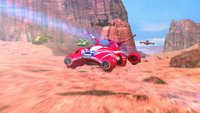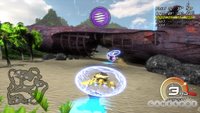
The PlayStation 3's release date may be only a few months away, but information continues to trickle out at a slower pace than we'd like on the upcoming megasystem's launch software. Dynasty Warriors maker Koei will provide its own addition to the PS3's initial lineup with Fatal Inertia--a futuristic hover racer in production at the company's new Toronto development studio--and the company was kind enough to give us an illustrated rundown of the arsenal you can expect to see when the game ships along with the PlayStation 3 in November. The Unreal Engine 3-powered game promises a set of weapons that uses physics in some creative ways to provide a more unique combat experience than you might be used to seeing in games of this type.
The Weapons of Fatal Inertia.
There are eight different weapons that can be picked up during a race in Fatal Inertia, and these weapons concentrate on affecting the physical performance of other vehicles in the race, rather than relying on standard conventions such as simple explosions. The player will use the weaponry at hand to either hinder the movement of enemy vehicles or to provide themselves with the edge that can take them to the head of the pack.
As in many racing games, you'll pick up weapons by flying over any of the weapon pads that are scattered throughout the course. One of the eight weapons described below will be randomly assigned to you each time you hit one of these pads.
Magnets.

Magnets are the archetypal weapon of the Fatal Inertia racing circuit. Shoot them toward your rivals, and watch as the magnetic properties of the other ships are attracted toward your target like a homing beacon. These magnets are oversized and add weight that adversely affects factors such as speed, handling, balance, and drag, making it that much harder for rival pilots to steer their ships. Stick a magnet on the right wing of a vehicle, and watch it veer off to the right; stick one on its tail, and watch the extra rear-end weight force the ship's nose upward. Based on real-life physical properties, the magnets will affect the performance of vehicles in exactly the way you would expect.
Most weapons, including the magnets, can either be shot forward at an enemy or dropped to affect enemies trailing close behind. Dropping a weapon at the right time can effectively throw a pursuer off your tail and can be the difference between victory and defeat.
Cluster Bombs.

A cluster bomb is equipped with proximity sensors that detonate when any metal object (including weapons and vehicles) is detected close by. Each cluster bomb consists of 10 magnets that fly out toward enemies upon detonation. This storm of magnets, if used properly, can be a devastatingly effective force against other vehicles. As the cluster itself does not have any magnetic properties (they fly in a straight line), the player will have to aim with precision to get the bomb close enough to the enemy.
The cluster bomb can be dropped on the ground, as well, where it will remain as an obstacle until detonated. Any ship getting too close will trigger the proximity sensor and be hit with a barrage of magnets.
Rockets.

Rockets are essentially magnets with rocket boosters strapped to them. When attached to an enemy vehicle, the booster ignites, exerting a huge force at the point where it's attached. The impacted player must try to compensate to avoid careening into canyon walls or spiraling off a cliff. The ship shown here has been hit by a rocket and is spinning out of control.
A twist on the standard weapon drop will let players "drop" rockets onto their own tail, providing a sudden and massive burst of speed.
Force Shield.

The force shield temporarily protects your ship from all enemy attacks, but it also deactivates your other weapons. It lessens the effects of bumping into objects or walls, as well.
All damage suffered by your vehicle during a race will be accurately reflected both visually and in performance, with the ship-control dynamics constantly changing depending on the condition of your ship. For example, clipping a wall too hard (such as when traveling at top speed) may cause a wing to break off outright, forcing you to fly with a reduced horizontal balance for the remainder of the race. Accumulating too much damage will cause the ship to explode, eliminating you from the race. However, damaged ships can be repaired by visiting the pit stop, located near the starting gates.
Smoke Screen.

The smoke screen releases a dense cloud of smoke from your tail, obscuring the vision of those immediately behind you. If you time it right, such as just before a sharp turn, you can send your rivals crashing blindly into a wall.
EMP.
The EMP sends out a pulse that temporarily incapacitates all other electronic devices within its immediate vicinity. Primarily, this will incapacitate the hovering capabilities of other ships. No longer able to hover, the ships will drop to the earth until their systems come back online. The EMP also disengages all weapons (such as magnets) in the vicinity.
Force Blast.
The force blast creates a powerful wave of energy immediately behind you, which will knock away rivals that are on your tail, provide a momentary burst of speed to your ship, alter the course of any weapons flying toward you, and knock off any weapons attached to your ship.
Time Dilator.

The time dilator slows the speed of time down to a crawl...for everyone except you. Take advantage of the momentary shift of time to blow past other vehicles in front of you. An extremely rare weapon, the time dilator can change the entire flow of a race in one shot, allowing a vehicle trailing far behind to suddenly leap to the front of the pack. Good players will be able to use the time director to evade enemy fire in midair or to make a slick avoidance maneuver as columns of rock are about to rain down from above.


1 comment:
Nice weapons.
Post a Comment